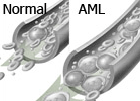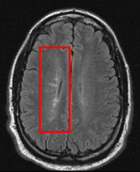 Welcome to the first issue of the new NRx (previously known as Net Results Express). It has been given a major visual redesign and a streamlined approach towards communicating scientific breakthroughs, major funding and honours awarded and other research related events at UHN. In NRx, you can read about ongoing research at our five research institutes, the Ontario Cancer Institute (OCI), the Toronto General Research Institute (TGRI), the Toronto Western Research Institute (TWRI), the Toronto Rehabilitation Institute (TRI) and the Techna Institute (Techna).
Welcome to the first issue of the new NRx (previously known as Net Results Express). It has been given a major visual redesign and a streamlined approach towards communicating scientific breakthroughs, major funding and honours awarded and other research related events at UHN. In NRx, you can read about ongoing research at our five research institutes, the Ontario Cancer Institute (OCI), the Toronto General Research Institute (TGRI), the Toronto Western Research Institute (TWRI), the Toronto Rehabilitation Institute (TRI) and the Techna Institute (Techna).
In this month’s issue you can read about research in:
- The role of intestinal bacteria in liver disease
- The effectiveness of stem cell transplant therapy for AML
- The development of new therapies against multiple sclerosis
- The challenges faced by arthritis patients in integrating physical activity into their daily life
- The strategies used by stroke patients to balance themselves while standing
We hope that you will find NRx informative and helpful. If you have feedback or questions, please contact www@uhnresearch.ca.
Christopher J. Paige, PhD, FCAHS
Vice President, Research
University Health Network

Weight loss and increased physical activity are currently the primary management regimens for non-alcoholic steatohepatitis.
The most common cause of fatty liver disease in Canada is obesity. How non-alcoholic fatty liver disease (NAFLD)—a term that describes a spectrum of changes in the liver associated with this condition, including inflammation and fibrosis and/or cirrhosis—manifests is not entirely understood but preliminary evidence suggests that intestinal microbes may contribute to its development.
TGRI Senior Scientist Johane Allard and her team performed a study to identify differences in intestinal microbes measured in stool samples from adults with NAFLD and healthy control subjects. The study results showed a significant association between the presence of non-alcoholic steatohepatitis, a more severe form of NAFLD, and a lower level of the gut bacteria Bacteroidetes, independent of diet or body mass.
Bacteroidetes is one of the main types of bacteria in the human gut. These findings suggest that it may play a role in NAFLD development and could also be a potential therapeutic target for this condition.
This work was supported by the Canadian Institutes of Health Research.
Intestinal microbiota in patients with non-alcoholic fatty liver disease. Mouzaki M, Comelli EM, Arendt BM, Bonengel J, Fung SK, Fischer S, McGilvray ID, Allard JP. Hepatology. 2013 February 11. [Pubmed abstract]

AML is characterized by an excess of abnormal white blood cells that crowd out the normal oxygen-carrying cells.
Myeloproliferative neoplasms are a group of diseases of the bone marrow where cells are produced in excess. In some cases, myeloproliferative neoplasms can transform into acute myeloid leukemia (AML), a cancer where an overgrowth of abnormal white blood cells prevents the production of normal blood cells. A particularly deadly complication, only 15% of AML patients will survive beyond two years. The rarity of transformation to AML makes it difficult to study, so the optimal treatment is unknown.
OCI Clinician-Investigator Dr. Vikas Gupta evaluated a treatment strategy of transplanting healthy blood cell-producing stem cells from a donor’s bone marrow or blood—a procedure known as hematopoietic cell transplantation—into patients with AML. In the study of 39 treated patients, chemotherapy was used to control the AML prior to transplantation; 13 patients had a good response to treatment yet were not eligible for a transplant and received the chemotherapy alone. Transplantation significantly improved outcomes over chemotherapy alone, with 47% of transplant patients surviving past the two year mark. “Transplantation should be the goal for all individuals at the outset of treatment,” Dr. Gupta concludes.
This work was supported by The Princess Margaret Cancer Foundation.
Treatment outcomes following leukemic transformation in Philadelphia-negative myeloproliferative neoplasms. Kennedy JA, Atenafu EG, Messner HA, Craddock KJ, Brandwein JM, Lipton JH, Minden MD, Schimmer AD, Schuh AC, Yee KW, Gupta V. Blood. 2013 January 29. [Pubmed abstract]

MS is characterized by lesions (red box) in the brain, caused by scarring of damaged neurons.
Myelin basic protein (MBP) is essential for the normal function of brain cells. In multiple sclerosis (MS), a form of MBP that contains citrulline is abnormally elevated, and this form is known to cause the irreversible brain cell damage that is a hallmark of MS. Citrulline is formed through a chemical modification by the protein peptidyl arginine deaminase 4 (PAD4). Using PAD4 as a potential target for treating MS, TGRI Scientist Dr. Lakshmi P. Kotra has developed a drug that could possibly reverse the function of PAD4 in MS and improve clinical outcomes.
Using computer modeling, Dr. Kotra screened a library of drugs that could theoretically block the function of PAD4. Ten drugs were identified and tested against PAD4 function. Of these, one drug—compound 4—showed promising activity and was tested in an experimental model of MS. After 24 days, compound 4 demonstrated improved clinical outcome in the model, including improved muscle tone. Dr. Kotra says, “Therapeutics targeting PAD enzymes could be developed as potential treatments for MS, with compound 4 being an excellent candidate.”
This research was supported by MaRS Innovation.
Novel inhibitors of protein arginine deiminase with potential activity in multiple sclerosis animal model. Wei L, Wasilewski E, Chakka SK, Bello AM, Moscarello MA, Kotra LP. Journal of Medicinal Chemistry. 2013 February 19. [Pubmed abstract]

Patients suffering from arthritis often express concern regarding exercise as it can be both detrimental and beneficial.
Studies indicate that physical activity (PA) can be therapeutically beneficial to the health of patients with arthritis; however, most of these studies do not typically take into account the role of PA on a patient’s work and family roles. In a recent study, TWRI Senior Scientist Dr. Monique Gignac and collaborators examined the effect PA has on the everyday lives of arthritis patients.
Most of the patients in the study recognized that staying physically active was health promoting, yet they still considered it less important than their roles at work or in the family. In addition, half the patients in the study had not revealed their disease condition at work and so did not receive any support in the work place for managing physically demanding work activities. Explains Dr Gignac, “Our study uncovers the complexities many arthritis patients face when trying to incorporate PA into their competing life roles and highlights areas of new research and measurement that could provide guidance in addressing PA and employment sustainability.”
This study was supported by the Canadian Arthritis Network, a Networks of Centres of Excellence of Canada.
Choosing where to put your energy: A qualitative analysis of the role of physical activity in the lives of working adults with arthritis. Kaptein SA, Backman CL, Badley EM, Lacaille D, Beaton DE, Hofstetter C, Gignac MA. Arthritis Care and Research. 2013 January 17. [Pubmed abstract]

Individuals with stroke rely on visual cues more than others for balance control while standing.
Stroke survivors often suffer from partial weakening or paralysis of one side of the body, which is a condition known as hemiparesis. Recent findings have revealed that those with hemiparesis often shift their center of gravity towards the non-affected side in order to compensate. Surprisingly, some individuals do the opposite, applying more load to their weakened side—a strategy that may increase the risk of falls.
To shed light on the implications of this balance strategy, TRI Scientist Dr. Avril Mansfield carried out a study examining 147 chronic stroke patients with hemiparesis. Her team found that approximately 12% of the study participants bore more weight on their weakened side. Furthermore, these individuals relied more heavily on visual information to maintain balance and were more likely to show left-right instability versus individuals that distribute their weight equally. Dr. Mansfield emphasizes, “This study shows that stroke patients who use this strategy may be at increased risk of losing balance when their vision is impaired.”
This study was supported by the Heart and Stroke Foundation Centre for Stroke Recovery, the Heart and Stroke Foundation of Canada, the Canadian Institutes of Health Research and the Canadian Stroke Network.
Determinants and consequences for standing balance of spontaneous weight-bearing on the paretic side among individuals with chronic stroke. Mansfield A, Danells CJ, Zettel JL, Black SE, McIlroy WE. Gait Posture. 2013 January 25. [Pubmed abstract]
 Dr. Keshavjee was recognized for his research in organ preservation and repair. His advances have significantly increased the number of donor lungs used to save lives with lung transplantation.
Dr. Keshavjee was recognized for his research in organ preservation and repair. His advances have significantly increased the number of donor lungs used to save lives with lung transplantation.  Dr. Robinson was recognized for her work in women’s mental health. She co-founded Canada's first rape crisis centre and helped establish the College of Physicians and Surgeons of Ontario's task force on physician-patient sexual abuse.
Dr. Robinson was recognized for her work in women’s mental health. She co-founded Canada's first rape crisis centre and helped establish the College of Physicians and Surgeons of Ontario's task force on physician-patient sexual abuse. TGRI Senior Scientist Dr.
TGRI Senior Scientist Dr.  TRI Senior Scientist Dr.
TRI Senior Scientist Dr.